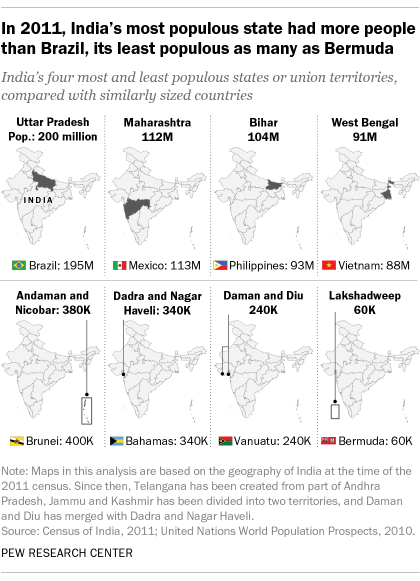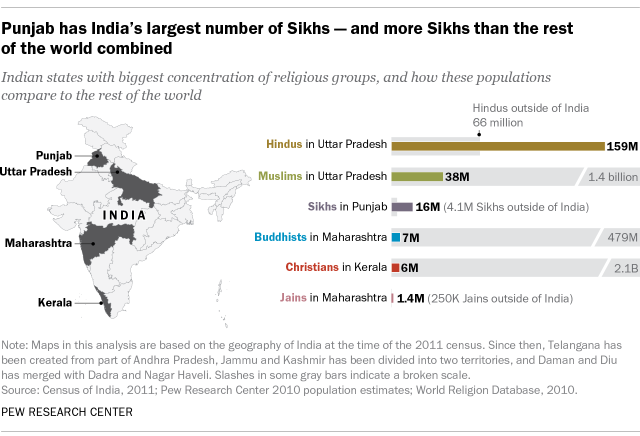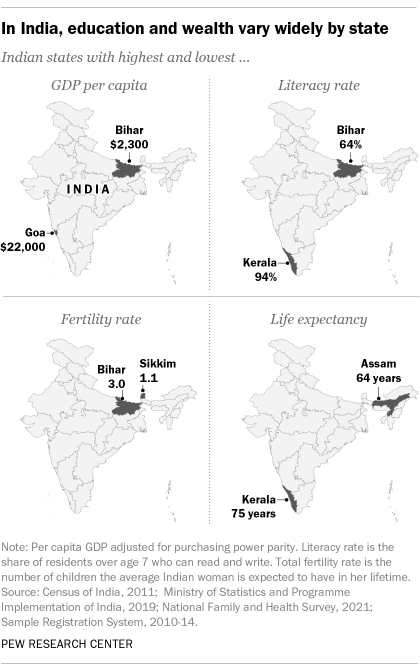With more than a billion inhabitants, India is the world’s second-most populous country and religiously, culturally and demographically diverse. A majority Hindu nation, India is also home to most of the world’s Sikhs and Jains and some of the world’s largest Muslim and Buddhist populations. India’s dozens of states and union territories also vary widely from each other. To highlight some of these differences, here are key facts about India’s states, based on the country’s most recent census, conducted in 2011, as well as Pew Research Center’s global population estimates for 2010 and other sources.
Pew Research Center conducted this analysis as part of a series of studies on India’s religious demography, and religious attitudes and practices in the country. Sourcing can be found in the hyperlinks included.
India’s most populous state or territory had more people than Brazil in 2011, while its least populous one had about as many people as Bermuda. Uttar Pradesh, India’s most populous state, was home to about 200 million people in 2011. If Uttar Pradesh were its own country, it would have been the world’s fifth-most populous that year, ahead of Brazil (195 million people) and Pakistan (174 million).
India’s second- and third-most populous states, Maharashtra (112 million) and Bihar (104 million), had roughly the same number of inhabitants as Mexico and the Philippines, the world’s 11th- and 12th-most populous countries in 2011.
India’s least populous territory, the southern archipelago of Lakshadweep, had about 60,000 people in 2011. That was on par with Greenland and Bermuda, and equaled roughly a tenth of Wyoming’s residents at that time.
Hindus were a majority in 28 of India’s 35 states in 2011. Around 94% of the world’s Hindus (966 million) lived in India in 2011. In fact, the Hindu population in any one of these four Indian states – Uttar Pradesh, Maharashtra, Bihar and Andhra Pradesh – exceeded that of every country outside of India combined.
Maharashtra – which lies on India’s western coast and includes Mumbai, India’s financial center and biggest city – also had the country’s largest numbers of Jains and Buddhists. Sikhs, meanwhile, were concentrated in the Northern state of Punjab, on the Pakistani border. About 58% of Punjab’s 28 million inhabitants were Sikh in 2011, making the state home to most of the world’s Sikhs.
India’s states and territories vary widely in wealth, as measured by per capita gross domestic product in 2019 and 2020. Bihar, near the northeastern border and not far from Nepal and Bangladesh, had the lowest per capita GDP in India, at about $2,300 (adjusted for purchasing power parity), according to Indian government data. That was similar to the per capita GDP of Mali or Rwanda. Goa, on India’s western coast along the Arabian Sea, was about 10 times as wealthy as Bihar and had India’s highest per capita GDP of $22,000, similar to that of Bulgaria.
Literacy rates differ by state in India. The nation’s poorest state, Bihar, had the country’s lowest literacy rate in 2011, with 64% of inhabitants over age 7 who could read and write, according to the Indian census. In Kerala, the state with the highest share of literate residents, the rate was 94%. (Kerala was also one of India’s most religiously diverse states, with large shares of Hindus, Muslims and Christians.)
Among all Indians, about three-quarters (74%) could read and write in 2011. This was comparable to the literacy rates of Morocco (74%) and Rwanda (73%), and lower than the rate of 99% in the United States, according to the World Bank. Worldwide, 84% could read and write in 2011.
The average Indian woman has between one and three children in her lifetime, depending on where she lives, a range that is partly tied to differences in wealth and other indicators of prosperity. On the low end of the spectrum, the fertility rate in the Northeastern state of Sikkim is about 1.1, according to India’s most recent 2021 National Family and Health Survey. That rate is similar to Singapore’s, and well below the approximately 2.1 children per woman needed for each generation to replace itself.
In Bihar, on the other hand, the average woman is expected to have three children, about as many as the average Algerian or Israeli woman. In the U.S., the total fertility rate is 1.6, according to the Centers for Disease Control and Prevention. The global fertility rate is about 2.4.
Life expectancy varies by more than a decade across Indian states. The average person in Assam could expect to live to be about 64 in 2011, while a resident of Kerala could expect to live to age 75. Overall, life expectancy in India was 68 years – the same as in Guyana during that time, and three years less than worldwide life expectancy of 71. The U.S. life expectancy in 2011 was 79 years, although it varied by state in the U.S. too.



